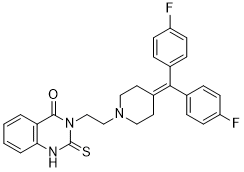
| 规格 | 价格 | 库存 | 数量 |
|---|---|---|---|
| 25mg |
|
||
| 50mg |
|
||
| 100mg |
|
||
| 250mg | |||
| 500mg | |||
| Other Sizes |
| 体外研究 (In Vitro) |
R59949 存在时,加压素和胶原诱导的释放反应和聚集显着增强,这与花生四烯酸代谢物的产生有关 [1]。 R59949 限制 THP-1 单核细胞中 CCL2 的输入。通过降低血管平滑肌细胞质膜上 L-精氨酸溶液的浓度,R59949 吸附诱导型一氧化氮的产生 [4]。 Ca2+ 信号的半最大浓度为 8.6 μM[2]。
|
|---|---|
| 参考文献 |
|
| 其他信息 |
3-[2-[4-[bis(4-fluorophenyl)methylidene]-1-piperidinyl]ethyl]-2-sulfanylidene-1H-quinazolin-4-one is a diarylmethane.
|
| 分子式 |
C28H25F2N3OS
|
|---|---|
| 分子量 |
489.58
|
| 精确质量 |
489.169
|
| CAS号 |
120166-69-0
|
| PubChem CID |
657356
|
| 外观&性状 |
White to off-white solid powder
|
| 密度 |
1.36g/cm3
|
| 沸点 |
637.1ºC at 760mmHg
|
| 闪点 |
339.1ºC
|
| 蒸汽压 |
3.94E-16mmHg at 25°C
|
| 折射率 |
1.688
|
| LogP |
5.873
|
| tPSA |
73.12
|
| 氢键供体(HBD)数目 |
1
|
| 氢键受体(HBA)数目 |
5
|
| 可旋转键数目(RBC) |
5
|
| 重原子数目 |
35
|
| 分子复杂度/Complexity |
770
|
| 定义原子立体中心数目 |
0
|
| InChi Key |
ZCNBZFRECRPCKU-UHFFFAOYSA-N
|
| InChi Code |
InChI=1S/C28H25F2N3OS/c29-22-9-5-19(6-10-22)26(20-7-11-23(30)12-8-20)21-13-15-32(16-14-21)17-18-33-27(34)24-3-1-2-4-25(24)31-28(33)35/h1-12H,13-18H2,(H,31,35)
|
| 化学名 |
3-(2-(4-(bis(4-fluorophenyl)methylene)piperidin-1-yl)ethyl)-2-thioxo-2,3-dihydroquinazolin-4(1H)-one
|
| 别名 |
R-59949 R59949 R 59949
|
| HS Tariff Code |
2934.99.9001
|
| 存储方式 |
Powder -20°C 3 years 4°C 2 years In solvent -80°C 6 months -20°C 1 month 注意: 请将本产品存放在密封且受保护的环境中(例如氮气保护),避免吸湿/受潮。 |
| 运输条件 |
Room temperature (This product is stable at ambient temperature for a few days during ordinary shipping and time spent in Customs)
|
| 溶解度 (体外实验) |
DMSO : ~100 mg/mL (~204.26 mM)
|
|---|---|
| 溶解度 (体内实验) |
配方 1 中的溶解度: ≥ 2.5 mg/mL (5.11 mM) (饱和度未知) in 10% DMSO + 90% Corn Oil (这些助溶剂从左到右依次添加,逐一添加), 澄清溶液。
例如,若需制备1 mL的工作液,可将100 μL 25.0 mg/mL 澄清 DMSO 储备液加入900 μL 玉米油中,混合均匀。 请根据您的实验动物和给药方式选择适当的溶解配方/方案: 1、请先配制澄清的储备液(如:用DMSO配置50 或 100 mg/mL母液(储备液)); 2、取适量母液,按从左到右的顺序依次添加助溶剂,澄清后再加入下一助溶剂。以 下列配方为例说明 (注意此配方只用于说明,并不一定代表此产品 的实际溶解配方): 10% DMSO → 40% PEG300 → 5% Tween-80 → 45% ddH2O (或 saline); 假设最终工作液的体积为 1 mL, 浓度为5 mg/mL: 取 100 μL 50 mg/mL 的澄清 DMSO 储备液加到 400 μL PEG300 中,混合均匀/澄清;向上述体系中加入50 μL Tween-80,混合均匀/澄清;然后继续加入450 μL ddH2O (或 saline)定容至 1 mL; 3、溶剂前显示的百分比是指该溶剂在最终溶液/工作液中的体积所占比例; 4、 如产品在配制过程中出现沉淀/析出,可通过加热(≤50℃)或超声的方式助溶; 5、为保证最佳实验结果,工作液请现配现用! 6、如不确定怎么将母液配置成体内动物实验的工作液,请查看说明书或联系我们; 7、 以上所有助溶剂都可在 Invivochem.cn网站购买。 |
| 制备储备液 | 1 mg | 5 mg | 10 mg | |
| 1 mM | 2.0426 mL | 10.2128 mL | 20.4257 mL | |
| 5 mM | 0.4085 mL | 2.0426 mL | 4.0851 mL | |
| 10 mM | 0.2043 mL | 1.0213 mL | 2.0426 mL |
1、根据实验需要选择合适的溶剂配制储备液 (母液):对于大多数产品,InvivoChem推荐用DMSO配置母液 (比如:5、10、20mM或者10、20、50 mg/mL浓度),个别水溶性高的产品可直接溶于水。产品在DMSO 、水或其他溶剂中的具体溶解度详见上”溶解度 (体外)”部分;
2、如果您找不到您想要的溶解度信息,或者很难将产品溶解在溶液中,请联系我们;
3、建议使用下列计算器进行相关计算(摩尔浓度计算器、稀释计算器、分子量计算器、重组计算器等);
4、母液配好之后,将其分装到常规用量,并储存在-20°C或-80°C,尽量减少反复冻融循环。
计算结果:
工作液浓度: mg/mL;
DMSO母液配制方法: mg 药物溶于 μL DMSO溶液(母液浓度 mg/mL)。如该浓度超过该批次药物DMSO溶解度,请首先与我们联系。
体内配方配制方法:取 μL DMSO母液,加入 μL PEG300,混匀澄清后加入μL Tween 80,混匀澄清后加入 μL ddH2O,混匀澄清。
(1) 请确保溶液澄清之后,再加入下一种溶剂 (助溶剂) 。可利用涡旋、超声或水浴加热等方法助溶;
(2) 一定要按顺序加入溶剂 (助溶剂) 。
|
|
|